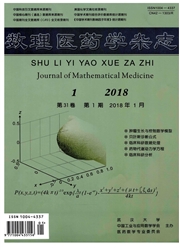

 中文摘要:
中文摘要:
目的:比较logistic回归分析中估计回归系数可信区间及假设检验的三种方法。方法:从理论上介绍Wald、Bootstrap和轮廓似然三种方法,比较其应用前提。应用Monte-Carol模拟方法,分别产生自变量为二分类变量和连续型变量的二分类logistic分析数据,比较三种方法的准确性和稳定性。结果:无论自变量为连续型或二分类变量,Bootstrap法和轮廓似然法的检验效能均高于Wald法,该差异在小样本情形下更为明显。但Bootstrap方法的稳定性较差,对Ⅰ类错误的控制也欠佳。结论:轮廓似然方法最为稳健,能严格控制I类错误率,且检验效能优于wald方法,值得推荐。
 英文摘要:
英文摘要:
Objective: To compare the statistical performances of three statistical methods in estimating confidence interval of regression coefficients and hypothesis testing in a logistic regression model. Methods: We introduced three methods, including the Wald-based, Bootstrap and Profile-likelihood method, and com- pared their assumptions. Then we generated logistic data regressed on a dichotomous-variable and a continu- ous-variable, respectively, using the Monte-Carlo method. Analyzing the simulated data using three different methods, we compared their accuracy and stability. Results: Whatever type of the variable is, the power of Bootstrap method and Profile-likelihood method are both higher than the Wald-based method, particularly in the case of small sample sizes. The Bootstrap method is relatively unstable and performs poorer in controlling the type I error. Conclusion. Profile-likelihood method can strictly control the type I error and always have a more efficient power than the Wald-based method, which should be strongly recommended.
 同期刊论文项目
同期刊论文项目
 同项目期刊论文
同项目期刊论文
 期刊信息
期刊信息
